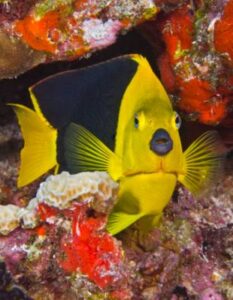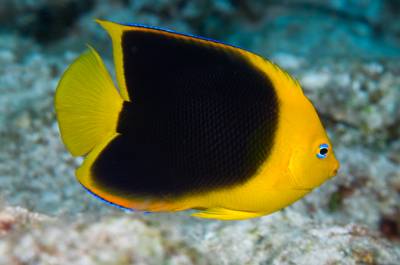
If you are like many underwater photographers I know, one factor that made you want to grab a camera system and try your hand at underwater photography was the allure of photographing fish. Occurring in what seems like endless shapes, colors, sizes, and patterns, there is no doubt that fish are wonderful subjects.

But creating a compelling photograph of a fish requires more than just pointing and shooting. In fact, for many of us figuring out how to compose a photograph of a fish when we first get started is more frustrating than we initially expect it to be. If that has happened to you, it’s no big deal. You are a member of a large club of underwater photographers. So, don’t give up!
Over the years I have developed an approach to fish photography that has helped me attain success when photographing fish. I’d like to share some of it with you here.
I divide my fish photographs into five categories as follows: (1) identification shot, (2) animated or more esthetically pleasing shot, (3) fish in its natural environment, (4) behavioral shot, and (5) close up of the face or some other body part. Some shots easily fit into more than one category. The idea is not to “put my photographs in a well-defined box”, but instead to help me have some ideas in mind when I see a fish so I don’t have to invent my plan when my subject is in front of me.
In addition to the categories, I consider the advantage shooting with a vertical or horizontal camera orientation. That gives me 10 categories, and that’s my approach in a nutshell.
When I encounter a fish, if I do not see it engaging in a behavior I want to capture, I usually opt to try to create an esthetically pleasing shot. It is the esthetically pleasing, or animated, shot that I want to discuss here. For an esthetically pleasing shot I want the fish facing toward my camera in an angular way. I usually don’t want the fish to be facing right at me. That idea often seems good underwater, but disappoints me later. So, I prefer an angular orientation.
I recommend trying to shoot at a slight upward or level angle. While slight downward shooting angle often works well, I do whatever I can to avoid shooting at a strong downward angle.
It is almost always very important to focus on the fish’s eye. Viewers relate to animals by looking at eyes and faces. So, out of focus eyes are usually a “deal breaker”.
Lastly, when I can I often try to compose the shot so that the viewer sees the fish in the context of its environment. This makes the shot a combination of “esthetically pleasing” and “fish in its natural environment”. That was my idea when photographing the rock beauty, an angelfish often seen in association with Caribbean reef communities, in the shot on the top. You can see the fish is facing me, I shot at a slight downward angle, the eye and face are in focus, and the fish lives in association with the reef.
In contrast, the shot on the bottom is an example of a less interesting identification shot. You can see the fish is a rock beauty, but the image lacks the impact of the image on your left.
I hope the information provided here gives you a starting point when photographing fish, and that the example images enable you to see the advantage that can be gained by having some ideas in mind regarding your composition before you ever encounter my subject. We hope to see you back again on the first. If you did benefit from this blog, please tell a friend about it.
Thank you,
Marty Snyderman from the Vivid-Pix Gang
